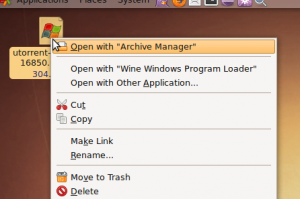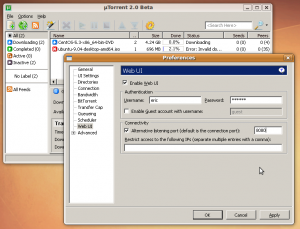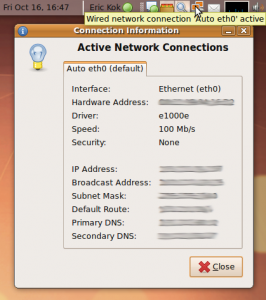Here are the steps to install Transdroid when you use µTorrent on Ubuntu:
Setting up µTorrent
It may seem strange to run µTorrent on Ubuntu since it is only available for Windows and Mac OS X. However, it runs very well using Wine on Ubuntu and since it is such a popular, fast and lightweight client it can still be a good alternative. Note however, that you will always need a running graphical front-end with an µTorrent instance.
µTorrent can be downloaded from the official website. Both the 1.8.x version and the new 2.0 beta should work. If you do not have Wine installed on Ubuntu, please do so first, by starting package installer with ‘Applications -> Add/Remove…’, selecting the ‘Wine’ package and applying this change. If you are used to using a terminal, run this command:
sudo apt-get install wine
Now, you can start µTorrent by right-clicking on the downloaded executable and choosing ‘Open with “Wine Windows Program Loader”‘. If you have downloaded the µTorrent installer version, you can also first install the software using Wine, with which you also get menu items in the ‘Applications’ menu.
The next step is to enable the web UI. Go to ‘Options -> Preferences’ and select the ‘Web UI’ tab. Here, check the ‘Enable Web UI‘ box and make up some name and password. I advise to check the ‘Alternative listening port’ box as well and set it to port number 8080. Remember the username, password and port number, because we need them later on.
You should now test if the web UI works. Open your browser and go to http://localhost:8080/gui (assuming you indeed used port 8080). It will ask for your username and password. If you do not see the web UI or can’t log in, go back to the program to check you settings.
Remember that you always leave the application running to allow Transdroid to connect to it.
Allow access from anywhere
The next step is very important if you want to use Transdroid to control µTorrent from anywhere you go and not just your home Wi-Fi network. You will need to open up the port 8080 and redirect this to your home computer. First get your Ubuntu computer’s IP address. Right-click on the connections icons in the top panel; this is the NetworkManager Applet. If choose ‘Connection Information’ it will give you some statistics about your current computer’s network connection. You need the number that says ‘IP Address’. Note it down or remember it: this is your computer local IP address.
Now go to your the manager interface of your router or ADSL modem. It will most likely have a NAT tab or settings screen. Here you will need to set up a port forward from all external traffic on port number 8080 to you local computers’ IP address – the one that you just retrieved from the Ubuntu connection manager – on the same port. There are too many routers and ADSL modems to make detailed explanations here, but you can use the website PortForward for in-depth help.
Setting up Transdroid
The final step is to set up Transdroid. Install the software from the Android Market and open up the application. You will see a message that you need to set up a server configuration first. Hit your Android device’s menu button and choose ‘Settings’. Next, click the ‘Add a sever’ button to create your first sever configuration. You can add more later, if you need to.
Now fill in all the settings. The name is totally up to you. From the type menu you choose for µTorrent of course.
The IP address is your server’s external IP address. If you do not know this, open up a browser on your Ubuntu machine and surf to whatismyip.com. It will present you the external IP address that you need in Transdroid.
The port number is the next setting and is 8080. (Except for when you choose to use something else, of course.)
Choose to enable authentication and fill in the web UI username and password.
Time to test your settings! First disconnect from the Wi-Fi network if you are connected to the local network (the one where your Ubuntu machine is in as well). This is important, because you will need to use different settings for that.
Now, hit the back button of your Android device twice to return to the main screen. It should now state that it is connecting to the sever. After a couple of seconds you should get a listing of all the active torrents in uTorrent. Reward yourself by downloading some torrents, right from your phone. 🙂
Local Wi-Fi network access
One thing you should know when you have a Wi-Fi network at home, is that you cannot use your external IP address as described above while you are connected this way. When connected to the wireless network that your Ubuntu machine is in, you will need to use your machine’s internal IP address instead.
Easiest thing to do is to open Transdroid’s settings menu again and add a new sever configuration. Use the exact same details that you used before, but now use your Ubuntu machine’s local IP address. Of course you also want to give it a name that identifies it as being your local configuration.
Give it a test by going to the main screen and choose ‘servers‘ from the menu. You can select the other configuration from the pop-up menu. A little tip: switching servers can also be done by swiping your finger from left to right (or the other way around). No need to open the menu each time!
Troubleshooting
If Transdroid refuses to connect you, use these steps to trace the problem.
First try to connect to the web UI directly from your Ubuntu machine. Start a browser and surf to http://127.0.0.1:8080/gui. (Check if you indeed set the listening port to 8080 in µTorrent’s web UI settings.) If you receive a page not found error, you didn’t enable the web UI.
If you are presented a login screen but are refused access, please check your username and password, maybe re-enter them. As long as you cannot even access the web UI, Transdroid will not work as well.
If this direct connection works, check if you can connect using Transdroid while connected on your internal Wi-Fi network. Remember to use you internal IP address now. If this works but external connections via 3G/EDGE don’t, you have not set up the port forwarding correctly.
Still having troubles? Use the ‘error report’ feature in Transdroid’s menu to get personal help.
Good luck and enjoy!


